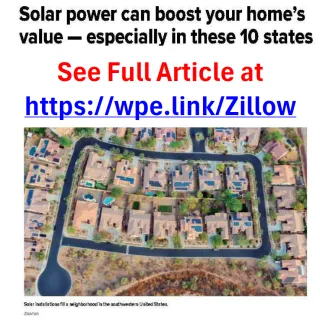Frequently Asked Questions
(Many more questions with answers coming soon!)
(¡Muchas más preguntas con respuestas próximamente!)
English - FAQ
Español - FAQ

1. Can a house run purely on solar power?
It's possible for a house to run purely on solar power with a large enough system and battery storage but no NJ townships will allow you to completely remove yourself from the grid.

2.. What factors determine if solar is worth it for a homeowner?
Factors like electricity rates, sunlight availability, incentives, and financing options determine if solar is worth it financially.

3. How can I calculate potential savings from solar panels?
Online solar calculators estimate potential savings based on electricity usage, system size, and local conditions.

4. What is the average break-even point for a solar panel system?
The average break-even point or payback period for a solar system is 7-9 years.

5. How does the quality of solar equipment impact performance?
Higher quality solar equipment like panels and microinverters improve system performance and longevity.

6. What are some alternatives to installing solar panels?
Alternatives to installing solar include community solar projects and energy efficiency upgrade

7. What are the long-term savings potential of solar panels?
Long-term savings potential from solar is $20,000 to $97,000 over 25 years.

8. How much can solar panels reduce energy bills?
Solar can reduce energy bills by covering some or all of a home's electricity needs.

9. How do solar panels reduce carbon emissions?
Solar reduces carbon emissions by providing clean, renewable electricity.

10. How do solar panels reduce carbon emissions?
Solar reduces carbon emissions by providing clean, renewable electricity.

11. What are the financial incentives for installing solar panels
Federal Solar Tax Credit
The federal solar investment tax credit (ITC) is one of the most substantial incentives. It allows you to deduct 30% of the cost of installing a solar photovoltaic (PV) system from your federal taxes. This credit was to be available through 2032 and applies to both residential and commercial solar installations but, unfortunately congress is voting it out of existence right now in July of 2025.
Solar Renewable Energy Certificates (SRECs)
In certain states with SREC markets, homeowners can sell certificates representing the environmental attributes of the solar electricity their system generates. The income from SREC sales can help recoup the solar investment over time.
To maximize the financial benefits, it's crucial to research and take advantage of all the solar incentives available in your state and from your local utility. Working with an experienced solar installer can also ensure you receive the proper credits and incentives.

12. How do state-specific solar incentives compare to federal incentives
State-specific solar incentives can vary significantly in their types and values compared to the federal solar investment tax credit (ITC). Here's a comparison of state and federal solar incentives:
## Federal Solar Investment Tax Credit (ITC)
- Provides a 30% tax credit on the cost of installing a residential or commercial solar photovoltaic (PV) system.
- The 30% credit is available through 2032, then steps down to 26% in 2033 and 22% in 2034 before being eliminated for residential systems in 2035.
- Applies to the total system cost including equipment, labor, and permitting fees.
- Is a non-refundable credit, meaning it cannot exceed the taxpayer's federal income tax liability for that year.
## State Solar Incentives
States offer a variety of solar incentives that can be used in addition to the federal ITC. Common state incentives include:
### State Tax Credits
- Similar to the federal ITC but apply to state income taxes instead.
- Typical values range from 10-35% of system costs, with some capped at fixed dollar amounts like $5,000-$10,000.
- Examples: New York (25% up to $5,000), Massachusetts (15% capped at $1,000).
### Rebate Programs
- Provide upfront cash rebates based on the system's size or expected production.
- Values can be a fixed dollar amount per watt ($/W) of installed capacity.
- Examples: California's SGIP rebates for solar+storage, Oregon's residential rebates up to $5,000.
### Renewable Energy Credits (RECs/SRECs)
- Allow system owners to sell certificates representing the renewable energy their system generates.
- Provides an income stream, but market values for RECs/SRECs can fluctuate over time.
- Active SREC markets exist in states like Massachusetts, New Jersey, and Pennsylvania.
### Net Metering
- Requires utilities to credit customers at the retail electricity rate for excess solar power sent to the grid.
- Net metering policies and crediting rates differ across states and utilities.
### Tax Exemptions
- Some states exempt solar installations from sales tax or increased property taxes.
While the federal ITC provides a consistent 30% tax credit nationwide, state incentives are highly location-dependent. Some states like California, New York, and Massachusetts offer very generous incentives, while others have minimal or no state programs. Working with a reputable local solar installer is key to taking maximum advantage of all incentives available.

13. How much can solar panels reduce energy costs for a typical home in NJ?**
For an average-sized home in New Jersey using around 8,000 kWh of electricity per year, installing a 6 kW solar panel system could offset 70-100% of the annual electric utility costs. Depending on the local utility rates, this could amount to $1,000 - $1,500 in yearly savings after the system costs are paid off, which takes 5-8 years on average with NJ's solar incentives.

14. What are the current residential solar incentives available in New Jersey
1. Federal Solar Investment Tax Credit (ITC)
- Provides a 30% tax credit on the cost of installing residential solar systems.
- The 30% credit is ENDING this year which will result in 30% more expensive solar regardless if you pay cash, finance, lease or purchase the power
2. Successor Solar Incentive (SuSI) Program
- Allows homeowners to generate and sell solar renewable energy certificates (SRECs) for the solar electricity produced.
-This program is a guaranteed payout deposited in your bank account for 15 years
- For net-metered residential systems, one SREC-II certificate is earned per 1,000 kWh generated and can be sold at around $85 each.
- Estimated additional income of $850 per year on average.
-To calculate YOUR benefit, divide your annual solar production by 1000 then multiply by 85 to get your yearly benefit, then multiply by 15 to get your total benefit
3. Net Metering
- New Jersey has favorable net metering policies requiring utilities to credit homeowners at the full retail electricity rate for excess solar power sent to the grid.
- Unused credits can roll over month-to-month, with any remaining excess credited at the wholesale rate annually.
4. Sales Tax Exemption
- Solar equipment and installation costs are exempt from New Jersey's 6.625% sales tax.
5. Property Tax Exemption
- Any increase in home value due to the installed solar system is exempt from additional property taxes.
These incentives can substantially reduce the upfront cost of going solar in New Jersey and provide ongoing financial benefits through electricity bill savings, SREC income, and tax exemptions. The federal ITC and state's SuSI program are highlighted as two of the most impactful incentives available.

15. How does net metering work in New Jersey
1. Net Metering Requirement
All utilities regulated by the New Jersey Board of Public Utilities (BPU), including PSE&G, JCP&L, Atlantic City Electric, and Rockland Electric, are required to offer net metering to residential customers with solar photovoltaic (PV) systems.
2. Full Retail Rate Credits
When a solar PV system produces more electricity than the home uses, the excess electricity is sent to the utility grid. The homeowner receives full retail rate credits on their utility bill for each kilowatt-hour (kWh) of excess solar electricity sent to the grid.
3. Rolling Over Excess Credits
Any excess kWh credits earned in a given month roll over and can be used to offset the customer's electricity consumption in future months.
4. Annual True-Up
At the end of the 12-month billing cycle, if there are any remaining excess kWh credits, the utility compensates the customer for those credits at the wholesale electricity rate rather than the full retail rate. This wholesale rate compensation is known as the "avoided cost rate."
5. System Size Limit
To be eligible for net metering, a residential solar system must be sized such that the estimated annual energy production does not exceed the customer's total annual electricity consumption.
6. Statewide Capacity Limit
While there is no firm statewide cap on net metering currently, the BPU can choose to limit net metering to 2.9% of each utility's total annual electricity sales from the prior year.
7. Meter Aggregation
New Jersey allows aggregated net metering, where a single customer can offset electricity consumption across multiple meters, but this is limited to public entities like state/local governments and schools.
So in summary, favorable net metering rules in New Jersey enable homeowners to receive full retail rate bill credits for excess solar electricity sent to the grid each month, with annual true-ups compensated at the wholesale rate. System sizing and statewide caps apply.

16. How does net metering impact my overall electricity bill
Net metering can significantly reduce your overall electricity bill by allowing you to offset the electricity you consume from the utility with the excess solar electricity your system sends back to the grid. Here's how it works:
1. Full Retail Rate Credits
When your solar panels produce more electricity than your home is using at that time, the excess gets sent to the utility grid. You receive full retail rate credits on your utility bill for each kilowatt-hour (kWh) of this excess solar electricity. These credits offset the charges for the electricity you consume from the utility when your system is not producing enough.
2. Rolling Over Excess Credits
Any excess kWh credits earned in a given month roll over and can be applied to offset your electricity consumption and charges in future months. This allows you to maximize the value of your solar production year-round.
3. Annual True-Up
At the end of each 12-month billing cycle, if there are any remaining excess kWh credits, the utility will compensate you for those credits, typically at the wholesale electricity rate rather than the full retail rate. While lower than retail rates, this still provides some value for overproduction.
4. Reduced Electricity Purchases
By generating your own solar power and receiving credits for excess production sent to the grid, you can significantly reduce the amount of electricity you need to purchase from the utility each month. This translates to lower overall electricity bills.
5. No Additional Fees
With net metering, you avoid paying any additional fees or charges beyond your regular electricity rates. The credits are automatically applied to offset your utility costs.
The ability to receive full retail rate bill credits for excess solar power sent to the grid, along with rolling over unused credits month-to-month, are highlighted as the primary ways net metering can substantially reduce homeowners' overall annual electricity costs from the utility. The exact savings will depend on your system size, production levels, and electricity rates from your utility.

17. How do utilities balance the benefits of net metering with their own financial needs
Utilities need to balance the benefits of net metering for solar customers with their own financial requirements and grid management needs. Here's how they typically approach this:
1. Net Metering Caps and System Size Limits
Many utilities impose caps or limits on the total capacity of net-metered systems they will allow on their grid. This prevents too much distributed solar generation from impacting their revenues. There are also often limits on the maximum system size eligible for net metering for residential and commercial customers.
2. Retail Rate vs. Avoided Cost Credits
While some utilities provide full retail rate credits for excess solar power sent to the grid, others only credit at the utility's "avoided cost" wholesale rate, which is lower. This allows utilities to compensate solar customers fairly while not losing too much revenue from crediting at the higher retail rate.
3. Monthly Netting vs. Annual True-Up
Utilities can choose to provide net metering credits on a monthly netting basis, where excess generation rolls over month-to-month. Others employ an annual true-up where any remaining excess credits at year-end are compensated at a lower avoided cost rate. This limits the financial impact on the utility.
4. Fixed Charges and Minimum Bills
Some utilities have increased fixed customer charges or implemented minimum monthly bills for solar net metering customers. This ensures they can still recover some fixed costs for grid maintenance and operations.
5. Valuation Studies and Rate Revisions
Utilities periodically conduct cost-benefit studies to assess the value solar provides to the grid and their systems. Based on these, they may revise net metering policies, rates, and compensation levels to better align costs and benefits.
6. Grid Service Fees and Demand Charges
Certain utilities have added grid service fees, demand charges or standby charges specifically for solar net metering customers to recover grid costs and reduce the utility's revenue losses.
The key for utilities is finding the right balance between providing fair compensation for customer-sited solar through net metering, while also ensuring they can reliably maintain the grid and recover their prudently incurred costs of service. Revising policies over time based on solar growth and valuation studies helps achieve this balance.

18. How do solar panels affect my home's value and selling process?
Installing solar panels on your home is an investment that pays dividends in lower energy bills and reducing your carbon footprint. But did you know going solar can also increase the resale value of your property? Numerous studies have shown that buyers are willing to pay more for homes with existing solar panel systems.
According to a recent analysis by Zillow, New Jersey homes with solar panels sell for 9.9% more on average than comparable homes without solar across NJ. For a $500,000 home, having solar could potentially boost the sale price by almost $50,000.
The reasons are clear - buyers recognize the long-term energy savings and environmental benefits of solar. With decades of free electricity generation ahead, they are willing to pay a premium upfront for a solar system that is already installed and paid off. Additionally, solar is viewed as an attractive high-end feature that increases a home's market appeal.
So if you've gone solar, be sure to highlight it as a selling point when listing your home. Provide documentation on the system specifications, installation date, production estimates, warranties, and financial incentives utilized. This transparency helps buyers understand the value proposition.
People will stand in line, to pay more money, for a home with almost no electric bill.

19. What are a few key considerations for NJ solar homeowners when they sell their house?
1. Owned Systems: If you fully own the solar panels, they are considered part of the home's value. All rights and responsibilities transfer to the new owners.
2. Leased Systems: For leased or third-party owned systems, you'll need to transfer the remaining lease contract to the new owners or after 5 to 6 years (depending on the financier) you can purchase your system at “fair market value’, then sell your home with nearly no electric bill.
3. Loan Payments: If you financed the system with a solar loan, the new owners can take over the remaining payments or you can pay off the balance from the home sale proceeds then sell your home with nearly no electric bill.
4. Renewable Energy Credits: Find out if you need to transfer over any remaining renewable energy credits or incentives to the new owners.
By being upfront about your solar system details and working with your installer and realtor, you can ensure a smooth transfer and maximize the increased home value from going solar. An energy-efficient home with solar is a major selling point in today's market.

20. What are the long-term benefits of solar panels for home sellers
The key long-term benefits of having solar panels for home sellers are:
1. Increased Home Resale Value
Numerous studies have shown that homes with solar panels installed sell for a premium compared to homes without solar. According to research cited:
- According to Zillow, NJ homeowners increase their home value by 9.9% immediately. To see the full article, click here: https://wpe.link/Zillow
2. Faster Home Sales
Studies indicate that homes with solar panels tend to sell faster than comparable non-solar homes. The added value and energy savings appeal to environmentally-conscious buyers.
3. Long-Term Utility Bill Savings
The solar panels continue providing free electricity generation for decades after installation, resulting in substantial long-term utility bill savings for the new homeowners. This is a major selling point.
4. Transferrable Solar Incentives/Credits
Certain solar incentives like renewable energy credits (SRECs) and net metering credits may be able to transfer to the new homeowner in some cases, adding further value.
5. Environmental Benefits
Having solar panels already installed allows new homeowners to immediately start reducing their carbon footprint and environmental impact from day one.
While there are some considerations around transferring solar leases/loans, the consensus is that owning solar panels outright provides the most long-term financial benefits for home sellers. The solar installation is viewed as a valuable asset that can significantly increase the home's marketability and sale price.

21. How quickly do homes with solar panels sell compared to those without
Homes with solar panels tend to sell faster than comparable homes without solar installations. Here are some key findings:
1. Data from Rocket Homes in 2021 showed that homes with solar panels spent 13.3% less time on the market compared to homes without solar power.
2. A study by Zillow found that homes with solar panels sell around 20% faster than homes without solar across the U.S. markets analyzed.
3. While exact statistics are not provided, multiple sources state that homes with solar panels generally sell faster than non-solar homes.
4. The faster sale times are attributed to the increased demand and appeal of homes with solar, which provide long-term energy savings and environmental benefits for buyers.
5. Having solar panels is highlighted as a major selling point that can attract more interested buyers and give sellers an advantage in the real estate market.
The consensus from the search results is that installing solar panels can significantly decrease the number of days a home spends on the market before selling. The premium pricing, energy cost savings, and eco-friendly features of solar make these homes more desirable to many buyers. Exact sale timeframes may vary based on factors like location and market conditions, but the research indicates a clear tendency for solar homes to sell more quickly overall compared to non-solar properties.

22. What do I ask my solar advisor in order to educate myself about the benefits of solar panels
These are some effective ways to educate potential home buyers about the benefits of having solar panels:
1. Highlight the Financial Savings
Emphasize how solar panels can lead to significant long-term savings on electricity bills. Provide estimates on the projected utility cost reductions and the payback period for recouping the installation costs.
2. Showcase Environmental Benefits
Many buyers are environmentally conscious, so highlight how solar panels reduce a home's carbon footprint and reliance on fossil fuels. Explain how solar is a clean, renewable energy source.
3. Discuss Increased Home Value
Cite studies and data points indicating that homes with solar panels tend to sell faster and for higher prices compared to similar non-solar homes. This demonstrates the investment value of solar.
4. Provide Documentation
Have clear documentation ready on the solar system details - size, age, production estimates, financial incentives used, warranties, etc. This transparency builds trust with buyers.
5. Use Visual Aids
Incorporate photos, videos, graphics, and virtual tours highlighting the solar panels to help buyers better understand the system and its integration with the home.
6. Offer Tutorials
Provide simple tutorials or how-to guides explaining how the solar system works, net metering, monitoring production levels, and maintenance requirements.
7. Highlight Incentives
Make buyers aware of any remaining solar incentives, tax credits, renewable energy credits, or net metering benefits that can transfer to them.
8. Address Common Misconceptions
Be prepared to clarify misconceptions buyers may have about solar technology, upfront costs, reliability, or suitability for the local climate.
The key is using a multi-pronged approach with clear documentation, visuals, and addressing both the financial and environmental aspects to effectively convey the full benefits solar provides to potential home buyers.

23. Factors Affecting Solar Panel Costs
1. Energy Needs: The more electricity you use, the more solar panels you'll need.
2. Roof Specifications: The size, shape, and condition of your roof can influence installation costs.
3. Local Incentives: State and local incentives can significantly reduce your out-of-pocket expenses.
4. Type of Panels: There are different types of solar panels, each with varying costs and efficiency rates.
5. Installation Complexity: If your roof is complex or shaded, it might require more work to install the panels.

English - FAQ
Español - FAQ

¿Es financieramente beneficioso adoptar la energía solar a largo plazo?
Adoptar la energía solar es financieramente beneficioso a largo plazo, ya que puede ahorrar entre $20,000 y $97,000 en facturas de electricidad durante la vida útil de 25 años de los paneles solares.

¿Cuánto tiempo suelen durar los paneles solares?
Los paneles solares suelen tener una garantía de 25 años y pueden durar 35 años.

¿Los paneles solares proporcionan beneficios fiscales?
Sí, los paneles solares proporcionan beneficios fiscales como el crédito fiscal federal para energía solar, que cubre el 30% de los costos de instalación.



Facebook
Instagram
LinkedIn
Youtube